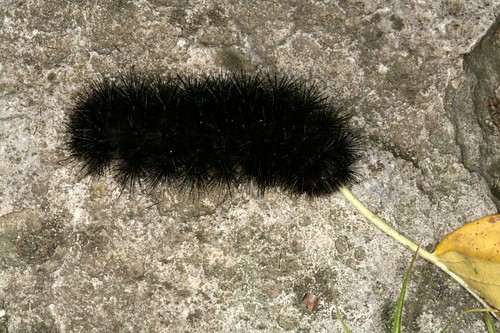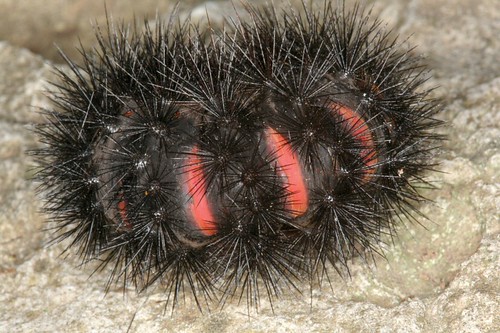tags: moth, Ecpantheria scribonia, giant leopard moth, Image of the Day
During the process of splitting and transferring wood from the woodpile yesterday, we discovered a large (2.5" long) hairy caterpillar. I have enclosed two pictures of it [the second is below the fold]; it is the larval stage of the Giant Leopard Moth, Ecpantheria scribonia. The life cycle is described and the adult is pictured here.
Image: Dave Rintoul [wallpaper size]
Image: Dave Rintoul, KSU [wallpaper size]



I wonder if anyone would like to take a shot at identifying a caterpillar I saw about a month ago. I don't have a photo of it. It was a bristled one like this, but a creamy tan with large black antenna. The antenna had rounded knobs on the end. It also had two black spiny protuberances on its tail. I live in the North Georgia mountains in a youngish hardwood forest.
Carolyn: The true antennae of caterpillars are usually very short and stubby, so you may have seen a caterpillar that had either fleshy filaments or thin bunches of long setae (hairs) that looked like antennae.
You might want to check out www.bugguide.net for some insect photos. It can be hard to ID a caterpillar from scratch there, but you might want to go to that site and search on "caterpillar" to see if anything looks familiar.
And, of course, beautiful E. scribonia. I love those caterpillars!
Thanks, Julie. I was very puzzled by those weird "antenna." It looked like a cartoon caterpillar or a good model for a stuffed animal and I'm very curious about it.
is the catapillar in this picture poisonus?
From the link to the adult, looks like this species of hairy catepillar is not poisonous although many other bristly ones are.
this goes to carolyn13 i think that what you saw was a wooly bear caterpillar, the link attached is helpful :D
http://en.wikipedia.org/wiki/Pyrrharctia_isabella
what does this catapillar eat because I found one and me and my science teacher I trying to make it go into a cucoon